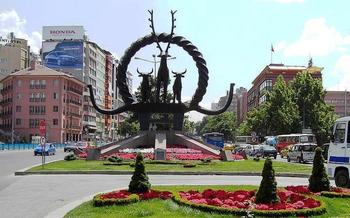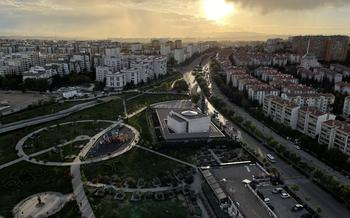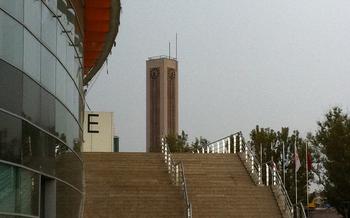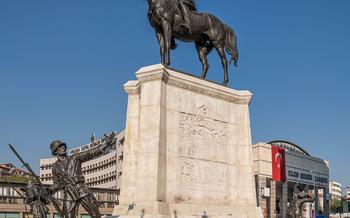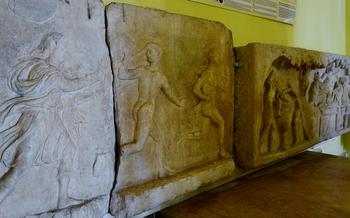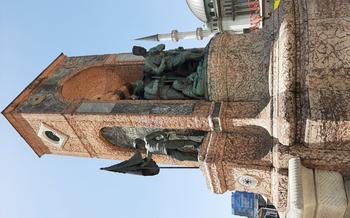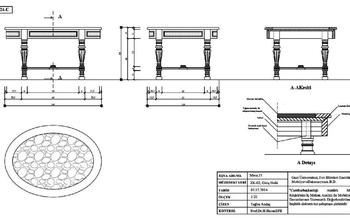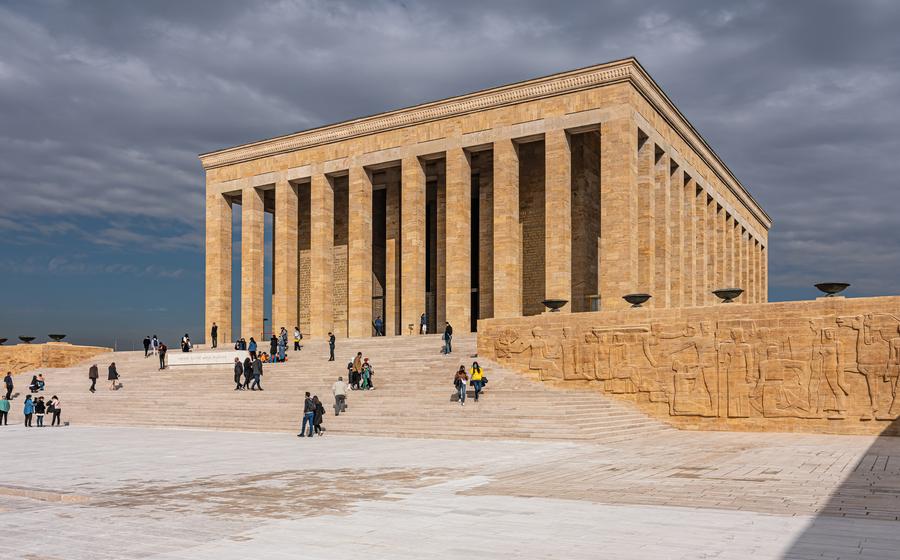
Atatürk Mausoleum (Anıtkabir)
- Atatürk Mausoleum (Anıtkabir): A Symbol of Turkish History and National Pride
- Location and Accessibility: Finding Anıtkabir
- History and Construction: Building the Mausoleum
- The Decision to Construct Anıtkabir
- The Architectural Competition and Emin Onat's Design
- The Construction Process and Challenges
- The Official Inauguration of Anıtkabir
- Architectural Design: Exploring Anıtkabir's Unique Features
- The Lion Road (Aslanlı Yol): A Path of Honor
- Hall of Honor (Şeref Salonu): A Place of Remembrance
- Atatürk Museum: Exploring the Life and Legacy of a Leader
- Changing of the Guard Ceremony: A Display of Precision and Honor
- Panorama 1915 Museum: A Journey Through History
- Anıtkabir Park: A Place of Tranquility and Reflection
- Accessibility for Visitors: Ensuring an Inclusive Experience
- Dress Code and Etiquette: Respecting the Mausoleum's Dignity
- Hours of Operation and Admission Fees: Planning Your Visit
- Insider Tip: Unveiling Hidden Gems
Atatürk Mausoleum (Anıtkabir): A Symbol of Turkish History and National Pride
The Atatürk Mausoleum, known as Anıtkabir, stands as a symbol of Turkish history and national pride, enshrining the final resting place of Mustafa Kemal Atatürk, the revered founder of the Turkish Republic. This magnificent mausoleum, situated on Anıttepe, a hill overlooking the capital city of Ankara, is not merely a tomb but a monument that embodies the transition of Turkey from the Ottoman Empire to a modern, secular republic.
Emin Onat, a renowned Turkish architect, designed Anıtkabir, blending traditional Anatolian and Seljuk architectural elements with modern design principles. The mausoleum's striking architecture reflects the synthesis of Turkey's rich past and its embrace of modernity. The Lion Road, Hall of Honor, and Atatürk Museum within the complex further enhance the symbolic significance of Anıtkabir, paying homage to Atatürk's legacy and his enduring impact on Turkish history and identity.
Location and Accessibility: Finding Anıtkabir
Anıtkabir is prominently situated on Anıttepe, a hill overlooking the majestic city of Ankara. Reaching the mausoleum is a breeze, with a range of transportation options at your disposal. Public transportation, including buses and subways, provides convenient access to Anıtkabir. For a more personalized experience, guided tours are readily available, offering insights into the mausoleum's history and significance.
Visitors with disabilities are welcomed with open arms at Anıtkabir. Thoughtful accessibility features, such as ramps and elevators, ensure that everyone can navigate the mausoleum complex with ease. Additionally, audio guides and guided tours in multiple languages cater to visitors with hearing impairments or limited English proficiency.
Combining a visit to Anıtkabir with other nearby attractions is a fantastic way to delve deeper into Turkey's rich history and culture. The Çankaya district, where Anıtkabir resides, is brimming with historical landmarks and cultural gems. The War of Independence Museum, dedicated to Turkey's struggle for independence, and the Museum of Anatolian Civilizations, showcasing the diverse cultural heritage of the region, are just a stone's throw away.
History and Construction: Building the Mausoleum
The Decision to Construct Anıtkabir
The decision to construct Anıtkabir was taken shortly after Atatürk's death in 193The Turkish government, recognizing the need to honor and commemorate the founder of the republic, commissioned an architectural competition for the design of the mausoleum. The competition was held in 1944, and Emin Onat's design was selected as the winning proposal.
The Architectural Competition and Emin Onat's Design
Emin Onat, a renowned Turkish architect, drew inspiration from ancient Anatolian and Seljuk architectural elements when designing Anıtkabir. The building's design incorporates traditional Turkish motifs and symbols, such as the crescent and star, which represent the Turkish Republic. The use of local materials, such as travertine and marble, adds to the mausoleum's significance as a national landmark.
The Construction Process and Challenges
The construction of Anıtkabir began in 1944 and was completed in 195The construction process was not without its challenges. The sheer size and complexity of the design, coupled with the limited resources available during the post-war period, presented significant obstacles. However, the construction team, driven by their dedication to Atatürk's memory, persevered and brought the mausoleum to completion.
The Official Inauguration of Anıtkabir
Anıtkabir was officially inaugurated on September 1, 1953, with a grand ceremony attended by dignitaries from around the world. The inauguration marked a significant moment in Turkish history, as it represented the culmination of a decade-long effort to honor the legacy of Mustafa Kemal Atatürk. Since its opening, Anıtkabir has become a symbol of Turkish national pride and a popular destination for visitors from Turkey and abroad.
Architectural Design: Exploring Anıtkabir's Unique Features
Among the striking architectural features of Anıtkabir is its unique fusion of traditional and modern styles. The mausoleum's design is inspired by ancient Anatolian and Seljuk architecture, evident in the use of geometric patterns, arches, and domes. Local materials such as travertine and marble were employed in the construction, adding to the building's sense of authenticity and connection to Turkish heritage.
Symbolic elements are incorporated throughout Anıtkabir's design, each holding a special meaning. The Lion Road, leading to the mausoleum, features 24 lions symbolizing strength, courage, and protection. The Hall of Honor, an impressive entrance hall, boasts marble columns, mosaics, and chandeliers, creating a grand and solemn atmosphere. The Atatürk Museum, housed within the mausoleum, showcases artifacts and personal belongings related to Atatürk's life and achievements, providing visitors with a deeper understanding of his legacy.
The harmonious blend of traditional and modern architectural elements in Anıtkabir reflects Turkey's transition from the Ottoman Empire to a modern republic. The mausoleum stands as a testament to Atatürk's vision of a progressive and forward-looking Turkey, while honoring its rich cultural heritage.
The Lion Road (Aslanlı Yol): A Path of Honor
Among the striking features of Anıtkabir is the Lion Road, a ceremonial pathway that leads visitors from the entrance to the mausoleum. This majestic road is lined with 24 imposing lion statues, each symbolizing strength, courage, and protection. The lions, inspired by Hittite motifs, stand guard along the 262-meter-long road, creating a sense of grandeur and reverence.
Walking along the Lion Road is a moving experience that sets the tone for the visit to Anıtkabir. The lions' fierce expressions and commanding presence evoke a sense of awe and respect. The road gradually ascends, leading visitors towards the mausoleum, and the rhythmic arrangement of the lions creates a visual rhythm that enhances the ceremonial atmosphere.
As you approach the mausoleum, the lions seem to gaze upon you, their stoic demeanor reminding you of the significance of the place you are about to enter. The Lion Road serves as a powerful symbol of the nation's gratitude and admiration for Atatürk, whose vision and leadership shaped the destiny of Turkey.
Hall of Honor (Şeref Salonu): A Place of Remembrance
Among the striking features of Anıtkabir is the Hall of Honor (Şeref Salonu), a grand entrance hall and gathering space within the mausoleum. Its impressive interior features include towering marble columns, intricate mosaics depicting scenes from Turkish history, and gleaming chandeliers that illuminate the vast space. Visitors are greeted by a sense of solemnity and respect as they enter the Hall of Honor, which serves as a place of remembrance and reflection for Atatürk's legacy.
In the center of the hall lies Atatürk's sarcophagus, a monumental structure crafted from a single block of white marble. The sarcophagus is adorned with intricate carvings and inscriptions, paying tribute to Atatürk's life and achievements. Above it hangs a massive chandelier, a symbol of the eternal flame that burns in the hearts of the Turkish people for their beloved leader.
The Hall of Honor also displays a collection of historical artifacts related to Atatürk's life and accomplishments. These include personal belongings, documents, and photographs that offer visitors a glimpse into the man behind the legend. Through these artifacts, visitors can learn more about Atatürk's childhood, his military career, his role in the Turkish War of Independence, and his vision for a modern and progressive Turkey.
The atmosphere within the Hall of Honor is one of reverence and gratitude. Visitors often pause to pay their respects to Atatürk, laying flowers or reciting prayers at his sarcophagus. The Hall of Honor serves as a powerful reminder of Atatürk's enduring legacy and the profound impact he continues to have on the Turkish nation.
Atatürk Museum: Exploring the Life and Legacy of a Leader
The Atatürk Museum, housed within Anıtkabir, serves as a repository of artifacts, documents, and personal belongings that offer a glimpse into the life and achievements of Mustafa Kemal Atatürk. Visitors can trace Atatürk's journey from his childhood in Thessaloniki to his military career and his pivotal role in the Turkish War of Independence. The museum's chronological displays showcase Atatürk's personal belongings, including his uniforms, medals, and handwritten notes, providing a tangible connection to the man who shaped Turkey's destiny.
Interactive exhibits and multimedia presentations bring Atatürk's story to life, allowing visitors to engage with his ideas and experiences. Through these interactive elements, visitors can gain insights into Atatürk's vision for a modern and progressive Turkey and his enduring legacy as a transformative leader. The museum stands as a testament to Atatürk's unwavering commitment to his country and his profound impact on Turkish history.
Changing of the Guard Ceremony: A Display of Precision and Honor
The Changing of the Guard Ceremony at Anıtkabir is a daily ritual that takes place with unwavering precision and solemnity. This symbolic ceremony honors the memory of Mustafa Kemal Atatürk and represents the Turkish military's unwavering commitment to his ideals.
Every day, a contingent of impeccably dressed guards marches with synchronized steps along the Lion Road, their movements accompanied by a stirring military march. The guards, clad in their ceremonial uniforms, exude an aura of discipline and respect as they approach the mausoleum.
The ceremony begins with the changing of the guard at the entrance to Anıtkabir, where the incoming and outgoing guards exchange salutes and positions. The incoming guards then march with unwavering precision towards the Atatürk Mausoleum, their footsteps echoing through the tranquil grounds.
As they reach the mausoleum, the guards perform a series of intricate maneuvers, their movements perfectly coordinated. They stand at attention, their heads bowed in reverence, as they pay their respects to Atatürk.
The Changing of the Guard Ceremony is a moving and awe-inspiring sight, showcasing the Turkish military's deep sense of honor and their commitment to preserving the legacy of Mustafa Kemal Atatürk. It is a must-see for anyone visiting Anıtkabir, offering a glimpse into the deep respect and admiration that the Turkish people hold for their founding father.
Panorama 1915 Museum: A Journey Through History
The Panorama 1915 Museum, located adjacent to Anıtkabir, is a must-visit for anyone interested in Turkish history and the Battle of Gallipoli, a defining moment in the country's struggle for independence. The museum houses a breathtaking 360-degree panorama depicting the battle's pivotal scenes, allowing visitors to immerse themselves in the heroic struggle of the Turkish forces.
The panorama, created by a team of talented artists, is a masterpiece of historical representation. It vividly portrays the fierce fighting, the landscapes of Gallipoli, and the indomitable spirit of the Turkish soldiers. Accompanied by a stirring soundtrack and realistic lighting effects, the panorama transports visitors back in time, creating an unforgettable and emotionally charged experience.
Through interactive exhibits and multimedia presentations, the museum delves deeper into the historical context of the Battle of Gallipoli. Visitors can learn about the strategic importance of the Dardanelles Strait, the motivations of the Allied forces, and the crucial role played by Mustafa Kemal Atatürk in leading the Turkish resistance.
The Panorama 1915 Museum is not only a tribute to the heroism of the Turkish soldiers but also a powerful reminder of the country's resilience and determination in the face of adversity. It is a place of remembrance, education, and national pride, offering visitors a unique opportunity to connect with Turkey's rich history and cultural heritage.
Anıtkabir Park: A Place of Tranquility and Reflection
Amidst the grandeur and historical significance of Anıtkabir, the surrounding park offers a serene retreat for visitors seeking tranquility and reflection. The meticulously landscaped grounds, adorned with a diverse array of trees, colorful flowers, and soothing water features, create a peaceful and contemplative atmosphere. Visitors can stroll along the well-manicured paths, immersing themselves in the beauty of nature while reflecting on the life and legacy of Atatürk. The park serves as a sanctuary for those seeking a moment of respite from the bustling city, inviting them to reconnect with their inner thoughts and emotions. Whether seeking solace, inspiration, or simply a peaceful retreat, Anıtkabir Park provides a haven for visitors to unwind, relax, and find solace amidst the historical significance of the mausoleum.
Accessibility for Visitors: Ensuring an Inclusive Experience
Anıtkabir is committed to providing an inclusive and accessible experience for visitors of all abilities. The mausoleum complex is equipped with ramps, elevators, and accessible restrooms, ensuring that visitors with disabilities can navigate the site with ease. Additionally, audio guides and guided tours are available in multiple languages, catering to visitors with hearing impairments or limited English proficiency. These efforts reflect Anıtkabir's dedication to ensuring that everyone can fully experience and appreciate the historical and cultural significance of this iconic landmark.
Dress Code and Etiquette: Respecting the Mausoleum's Dignity
When visiting Anıtkabir, it is essential to dress appropriately out of respect for Atatürk's memory and the significance of the site. Visitors should avoid wearing shorts, tank tops, and revealing clothing. Instead, they should opt for modest and respectful attire. Additionally, maintaining a respectful demeanor and tone of voice while inside the mausoleum is expected. Visitors should be mindful of their behavior and avoid creating disturbances that may disrupt the solemnity of the site. By adhering to these guidelines, visitors can contribute to preserving the dignity and sanctity of Anıtkabir, ensuring that all visitors can have a meaningful and respectful experience.
Hours of Operation and Admission Fees: Planning Your Visit
To plan your visit to Anıtkabir effectively, it's essential to be aware of its operating hours and admission fees. The mausoleum is generally open to the public daily, with varying hours depending on the season and day of the week. It's advisable to check the official website or contact the mausoleum administration for the most up-to-date information. Admission to Anıtkabir is usually free of charge, allowing visitors to explore the mausoleum and its grounds without any financial barriers. However, there may be special events or exhibitions that require a nominal fee. For visitors seeking a more in-depth experience, guided tours are available, providing valuable insights into the history, architecture, and significance of Anıtkabir. These tours may have additional charges, but they offer a comprehensive understanding of the mausoleum's importance in Turkish history and culture.
Insider Tip: Unveiling Hidden Gems
As you explore the vast complex of Anıtkabir, keep an eye out for hidden gems that offer a deeper dive into Turkish history and culture. The Atatürk Library, located within the mausoleum grounds, houses a vast collection of books, manuscripts, and personal belongings that belonged to Atatürk. It's a treasure trove for history buffs and anyone interested in learning more about the life and legacy of the founder of modern Turkey.
Venturing outside the mausoleum, explore the surrounding neighborhood of Çankaya, which is home to several historical landmarks and cultural attractions. Visit the impressive Çankaya Presidential Palace, the official residence of the Turkish President, or stroll through the serene streets lined with historic mansions and embassies.
To enhance your understanding of Anıtkabir's significance, consider joining a guided tour or participating in special events organized by the mausoleum administration. These tours often provide exclusive access to restricted areas and offer in-depth insights from knowledgeable guides.
Share your personal experiences and recommendations for making the most of a visit to Anıtkabir. Whether it's a favorite spot within the mausoleum, a hidden gem in the surrounding area, or a unique perspective on Turkish history, your insights can help fellow travelers create a truly memorable and enriching experience.


